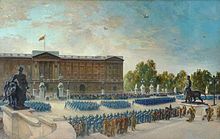Dia da Batalha de Inglaterra

O Dia da Batalha de Inglaterra, também conhecido como Dia da Batalha da Grã-Bretanha[1][2][3][4] deu-se no dia 15 de setembro de 1940, o dia em que ocorreu uma batalha aérea em grande escala na Batalha da Grã-Bretanha.
Em junho de 1940, a Wehrmacht conquistou a maior parte da Europa Ocidental e da Escandinávia. Naquela época, a única grande potência no caminho de uma Europa dominada pelos alemães era o Império Britânico e a Comunidade Britânica. Depois de ter várias ofertas de paz rejeitadas pelos britânicos, Adolf Hitler ordenou que a Luftwaffe destruísse a RAF a fim de obter superioridade aérea como um prelúdio para o lançamento da Operação Leão Marinho, um ataque anfíbio da Wehrmacht (forças armadas alemãs) contra as ilhas britânicas. Em julho de 1940, a Luftwaffe começou a fechar o Canal da Mancha para a navegação mercante. Em agosto, a Operação Adlerangriff (Ataque da Águia) foi lançada contra os aeródromos da RAF no sul da Inglaterra. Na primeira semana de setembro, a Luftwaffe não havia obtido os resultados desejados por Hitler. Frustrados, os alemães voltaram-se para o bombardeio estratégico de cidades, uma ofensiva que visava as indústrias militares e civis britânicas, mas também o moral civil. Os ataques começaram em 7 de setembro de 1940 e atingiram o clímax diurno em 15 de setembro.[5]
No domingo, 15 de setembro de 1940, a Luftwaffe lançou o seu maior e mais concentrado ataque contra Londres na esperança de levar a RAF a uma batalha de aniquilação. Cerca de 1 500 aeronaves participaram das batalhas aéreas que duraram até ao anoitecer. A acção foi o clímax da Batalha da Grã-Bretanha.[6] O Comando de Caças da RAF derrotou os ataques alemães. As formações da Luftwaffe foram dispersas por uma grande base de nuvens e não causaram danos graves à cidade de Londres. Após o ataque, Hitler adiou a Operação Leão Marinho. Tendo sido derrotada à luz do dia, a Luftwaffe voltou a sua atenção para a campanha nocturna The Blitz, que durou até maio de 1941.[5]
Comemoração
[editar | editar código-fonte]O Dia da Batalha da Grã-Bretanha é agora uma comemoração anual da batalha no Reino Unido, especialmente comemorada em 15 de setembro. No Canadá, a comemoração acontece no terceiro domingo de setembro.[7]
Referências
Bibliografia
[editar | editar código-fonte]
- Addison, Paul; Crang, Jeremy (2000). The Burning Blue: A New History of the Battle of Britain. London: Pimlico. ISBN 0-7126-6475-0
- Bergström, Christer (2007). Barbarossa – The Air Battle: July–December 1941. London: Chevron/Ian Allan. ISBN 978-1-85780-270-2
- Bishop, Ian (2009). Battle of Britain: A Day-to-day Chronicle, 10 July-31 October 1940. London: Quercus Publishing. ISBN 978-1-84916-989-9. (pede registo (ajuda))
- Bungay, Stephen (2000). The Most Dangerous Enemy: A History of the Battle of Britain. London: Aurum Press. ISBN 1-85410-721-6
- Collier, Richard (1980). Eagle Day: The Battle of Britain, 6 August – 15 September 1940. [S.l.]: J.M Dent and Sons. ISBN 0-460-04370-6
- Cooper, Mathew (1981). The German Air Force 1933–1945: An Anatomy of Failure. New York: Jane's Publishing. ISBN 0-531-03733-9
- Corum, James (1997). The Luftwaffe: Creating the Operational Air War, 1918–1940. [S.l.]: Kansas University Press. ISBN 978-0-7006-0836-2
- Dierich, Wolfgang (1975). Kampfgeschwader "Edelweiss": The history of a German bomber unit, 1935–45. London: Allan. ISBN 978-0-7110-0601-0
- de Zeng, Henry L.; Stankey, Doug G.; Creek, Eddie J. (2007). Bomber Units of the Luftwaffe 1933–1945: A Reference Source. 1. Hersham, Surrey: Ian Allan Publishing. ISBN 978-1-85780-279-5
- de Zeng, Henry L.; Stankey, Doug G.; Creek, Eddie J. (2007). Bomber Units of the Luftwaffe 1933–1945: A Reference Source. 2. Hersham, Surrey: Ian Allan Publishing. ISBN 978-1-903223-87-1
- Goss, Chris (2000). The Luftwaffe Bombers' Battle of Britain. [S.l.]: Crecy Publishing. ISBN 0-947554-82-3
- Hall; Quinlan (2000). KG55. [S.l.]: Red Kite. ISBN 0-9538061-0-3
- Hough, Richard; Richards, Denis (2007). The Battle of Britain. [S.l.]: Pen & Sword. ISBN 978-1-84415-657-3
- Hooton, E.R. (1994). Phoenix Triumphant: The Rise and Rise of the Luftwaffe. [S.l.]: Arms & Armour Press. ISBN 1-86019-964-X
- Hooton, E.R. (1997). Eagle in Flames: The Fall of the Luftwaffe. [S.l.]: Arms & Armour Press. ISBN 1-86019-995-X
- Hooton, E.R. (2010). The Luftwaffe: A Study in Air Power, 1933–1945. London: Classic Publications. ISBN 978-1-906537-18-0
- James, T.C.G; Cox, Sebastian (2000). The Battle of Britain. London: Frank Cass. ISBN 0-7146-8149-0. (pede registo (ajuda))
- Korda, Michael (2009). With Wings Like Eagles: A History of the Battle of Britain. London: Harper Books. ISBN 978-0-06-112535-5
- Mason, Francis (1969). Battle Over Britain. London: McWhirter Twins. ISBN 978-0-901928-00-9
- Murray, Willamson (1983). Strategy for Defeat. The Luftwaffe 1935–1945. Princeton, New Jersey: University Press of the Pacific. ISBN 0-89875-797-5
- Price, Alfred (1990). Battle of Britain Day: 15 September 1940. London: Greenhill Books. ISBN 978-1-85367-375-7
- Overy, Richard (1980). «Hitler and Air Strategy». Journal of Contemporary History. 15 (3): 405–421. doi:10.1177/002200948001500302
- Parker, Mathew (2001). Battle of Britain, July – October 1940. London: Headline. ISBN 978-0-7472-3452-4
- Terraine, John (1985). The Right of the Line: The Royal Air Force in the European War, 1939–1945. London: Sceptre Publishing. ISBN 0-340-41919-9. (pede registo (ajuda))
- Trevor-Roper, Hugh (2004). Hitler's War Directives; 1939–1945. [S.l.]: Birlinn. ISBN 1-84341-014-1
- Ray, John (2009). The Battle of Britain: Dowding and the First Victory, 1940. London: Cassel Military. ISBN 978-1-4072-2131-1
- Reynolds, David (1993). «Churchill in 1940: The Worst and Finest Hour». In: Blake, Robert; Louis, Wm. Roger. Churchill. [S.l.]: Oxford:Clarendon Press. ISBN 978-0198203179
- Wood, Derek; Dempster, Derek (1990). The Narrow Margin: The Battle of Britain and the Rise of Air Power 3 ed. London: Tri-Service Press. ISBN 1-85488-027-6
